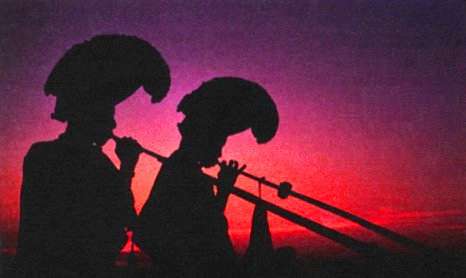 | - As It Was |
Tibet - As It Was
On This Page:- Mystique of Tibet - Introduction Stories of Tibetan Life
- Serenity in a Tibetan Monastery
- Hermit Lama Returns to the World
- Tulku - Rebirth of a Lama
- A Tibetan Ceremony
- A Lama's Remarkable Power
- Postscript - Tibet Irreversibly Changed
Mystique of Tibet - Introduction
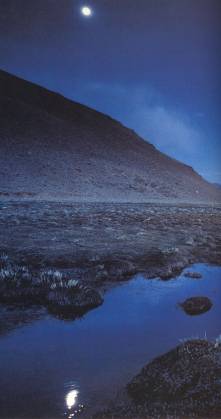 |
Serenity in a Tibetan Monastery
| The following entry is from The Way of the White Clouds, by Lama Anagarika Govinda. It relates his observations on being dropped unexpectedly into the strange universe of a Tibetan Buddhist Monastery. He tells of his encounter with a devoted old monk, follower of his future guru, and of the impact on his outlook and consciousness which subsequently changed the entire future direction of his life. |
While writing this, the delicate resinous scent of Tibetan incense is wafted through the shrine room of my little hermitage and immediately calls up the memory of the place where for the first time I became acquainted with this particular variety. I see myself seated in the dimly lit hall of a Tibetan temple, surrounded by a pantheon of fantastic figures, some of them peaceful and benevolent, some wild and frightening, and others enigmatic and mysterious; but all full of life and colour, though emanating from the depth of dark shadows.
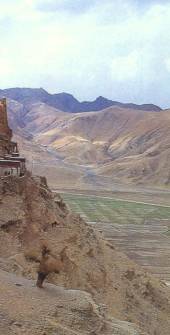 |
The abbot (of the temple) allowed me to settle down in a corner of the big temple as soon as it was possible to cross the courtyard which separated it from the main building of the monastery.
How did I get from the placid life of Ceylon's tropical paradise into this pandemonium of a Himalayan blizzard and the strange surroundings of a Tibetan monastery? Tibet had never figured in my plans or stirred my imagination. To me Ceylon had seemed the fulfillment of all my dreams; and in the certainty of living there to the end of my days I had built myself a hermitage in the heart of the island.
But one day I received an invitation to take part in an international Buddhist conference at Darjeeling as a delegate from Ceylon. After some initial hesitation I suddenly made up my mind, encouraged by the idea that here was an opportunity to uphold the purity of the Buddha's teachings, as preserved in Ceylon. And here I was in the middle of this weird world of Lamaism, neither knowing the language of the country nor the meaning of those countless images and symbols which surrounded me in the frescoes and statues of this temple, except when they represented the universally known figures of Buddhas and Bodhisattvas.
And yet when the day came on which the skies and the roads were open again and nothing stood in the way of my returning to the comforts of Darjeeling and the soft loveliness of Ceylon I was no more interested in making use of these opportunities. Some inexplicable force seemed to keep me back, and the longer I stayed on in this magic world into which I had dropped by a strange concatenation of circumstances, the more I felt that a hitherto unknown force of reality was revealed to me and that I was on the threshold of a new life.
I never realized it as strongly as on this occasion that the absence of the spoken work, the silent communion with things and people, which was forced upon me due to the lack of a common language, can bring about a deeper awareness and a directness of experience which generally is drowned by the incessant chatter under which human beings hide their fear of meeting each other in the nakedness of their natural being.
I had been given the privilege of being allowed to live in a corner of the temple: a big square hall, presided over by the gigantic statue of Buddha Maitreya, whose head would have lost itself in the darkness of the temple's upper regions had it not received the daylight coming through an opening of the raised central part of the roof, which was supported by tall red lacquered pillars with richly carved and gilded brackets.
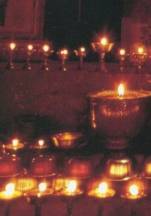 |
The walls, as far as their surface was visible to the eye - even above the tall wooden bookstands and behind the statues - were covered with frescoes, alive with the denizens of all the realms of existence: human, superhuman and non-human, divine and demonic, awe-inspiring and reassuring, fierce and compassionate ones. The were many armed monsters embracing each other in sexual union, surrounded by flames and smoke, and close to them enhaloed saints, serenely resting on lotus flowers, with devotees at their feet. There were fairies of tender beauty and fierce goddesses in ecstatic dance, adorned with skulls and garlands of human heads, while ascetics were absorbed in meditation and scholars in teaching their disciples. In between appeared wooded hills and snow clad mountains, trees and waterfalls, clouds and deep blue space and celestial bodies, while manifold birds and beasts and flowering trees animated the landscapes. At the bottom of all, the waters of the ocean with their treasures and pearls, jewels, and corals, as well as the serpent-spirits, the guardians of these treasures, became visible.
The whole universe seemed to be assembled in this temple, whose walls opened, as it were, into the depths of unheard of dimensions. And in the midst of this thousand-eyed, form-filled universe, overbrimming with life and possibilities of conscious experience, I lived in a state of wonder, contemplating and absorbing an infinite variety of impressions without trying to define or reason out their meaning - accepting them, as one accepts the landscapes of a foreign county through which one travels.
I was confronted with the accumulated visions of untold generations, visions based on inner experiences and on a spiritual reality over which my intellect had neither power nor judgment. And slowly this reality took possession of me, penetrating and superimposing itself upon my conception and evaluation of the material world and bringing about a subtle transformation in my conscious attitude towards it. I realized that religious truths and spiritual life are more a matter of transcending our habitual consciousness than of changing our opinions or building our convictions on the strength of intellectual arguments. Spiritual life is based on inner awareness and experience, which no amount of thinking could create.
Kachenla, Caretaker and Humble Teacher
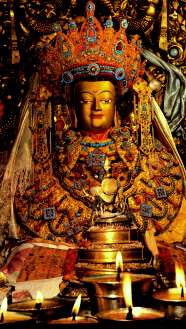 |
Sometimes in the middle of the night a strange shuffling sound awoke me, accompanied by what appeared to be the sound of heavy breathing. As the nights were very cold it took me some time before I could make up my mind to raise myself up and to look around. And then I saw the slowly moving figure of an old man in the open space before the alter, raising his joined hands above his head, going down upon his knees and hands, and then stretching himself out upon the floor in his full length after which he would get up and repeat the same exercise over and over again, until his breath was heavy with exertion. After that he moved silently along the walls, bowing before each of the images and touching the lower rows of the sacred books and the feet of Maitreya reverently with his forehead. He moved in a clockwise direction, and when coming back along the right wall towards my corner, I recognized him as the venerable old monk who lived in a small room flanking the porch that formed the entrance of the temple.
It was easy to recognize him because of his slightly bent figure and his long beard, which is comparatively rare among Tibetans. He was the oldest monk in the monastery and hailed from Shigatze. In his younger days he had been one of the personal attendants of the Tashi Lama, from whom he still received a small pension which, I found out later, he mainly used for the improvement and beautification of the temple, while he himself lived like the poorest and humblest of monks. He was bent not so much from age, perhaps as from sitting for years in a posture of meditation, and, in fact, his whole life seemed to be a continuous sadhana (religious practice).
In spite of his old age I never saw Kachenla unoccupied: whether he would glide about the temple on two square pieces of felt, in order to keep the floor polished, or whether he would attend to the hundreds of butter-lamps, water bowls, and other alter-vessels, which had to be kept clean and shining and filled with various ingredients - ever was he busy in the service of the temple or in the performance of his spiritual duties: reading the sacred texts, reciting prayers for the welfare of all living beings, and performing the daily rituals for their protection and well being. On special occasions he would make small clay images of great beauty. Every phase of the work was accompanied by mantras and prayers, invoking the blessings of the Enlightened Ones and the beneficient forces of the universe. Thus even a manual occupation was turned into a ritual of profound meaning and an act of devotion and meditation, whose forces would saturate even the material objects created in this way.
What Kachenla taught me in his humble way was more than I shall ever be able to convey in words. His devotion and his utter humility prepared my mind for the meeting with my Guru. He looked after my welfare as if I was his own son. He taught me the first words of Tibetan by pointing out things and pronouncing the names. In the morning he would bring me warm water - a luxury in which he himself would not indulge. He would share with me his beloved Tibetan butter tea, which was simmering the whole day long on his little charcoal stove behind which he had his seat.
In the evenings he would generally come into my quiet corner in the temple with a lit butter lamp, sit down before me on the floor and motion me to take out paper and pencil; and with infinite patience he would recite and dictate one prayer after another and make me repeat it until I caught the right pronunciation and intonation. It never bothered him that I could not understand a single word in the beginning, though he pointed out the image of the Buddhas and Bodhisattva concerned.
He seemed to be confident that he transmitted to me something that was of infinite value, whether I knew it or not; and to say the truth I experienced a similar satisfaction, because I was convinced that a gift given with such infinite love and devotion was valuable through this very fact, and indeed I felt that something was streaming over from the old man to me that filled me with happiness, though I could find no reasonable explanation for it. It was the first time that - without knowing it - I experienced the power of mantra, of sacred speech, in which the transcendental sound of the spirit that dwells in the human heart is perceived. And because it is the sound of the heart it cannot be heard by the ear or understood by the brain. But this I did not know yet, though I began to experience it.
 |
Hermit Lama Returns to the World
| The previous story continues on to describe Anagarika Govinda's future master, the hermit monk known as Tomo Geshe Rimpoche, who attained enlightenment and then returned to the world of his fellow men, to purify and rejuvenate the spiritual forces of Tibet. |
The Lama Ngawang Kalzang had been meditating for twelve years in various caves and retreats in the wilderness of the mountains of Southern Tibet. Nobody knew him, nobody had heard of him. He was one of the many thousands of monks who had received his higher education in one of the great monastic universities in the vicinity of Lhasa. He had come to the conclusion that realization can only be found in the stillness and solitude of nature.
The world had forgotten him and he had forgotten the world. This was not the outcome of indifference on his part but, on the contrary, because he had ceased to make a distinction between himself and the world. What actually he had forgotten was not the world but his own self, because the 'world' is something that exists only in contrast to one's own ego.
Wild animals visited him in his caves and made friends with him, and his spirit went out in sympathy to all living beings. Thus he never felt lonely in his solitude, and enjoyed the bliss of emancipation, born out of the exalted vision of Dhyana.
One day a herdsman in search of new grazing ground had lost his way in the inaccessible wilderness of rocks high above the valley when he heard the rhythmic beats of a hand-drum used by lamas mingled with the silvery sound of a ritual bell. At first he did not believe his ears, because he could not imagine that any human being could exist in this forbidding place.
Torn between fear and curiosity, he followed the sound, as if drawn by the irresistible force of a magnet, and soon he saw the figure of a hermit, seated before a cave, deeply absorbed in his devotional practice. The hermits face was serene, lit up with the fire of inspiration and devotion. The herdsman immediately lost all fear, and after the hermit had finished his invocations he confidently approached the Lama and asked for his blessing.
When the hermit touched the crown of his head he felt a stream of bliss flowing through his body, and he was filled with such unspeakable peace and happiness that he forgot all the questions he had wanted to ask, and hurried down into the valley to bring the happy news of his discovery to the people there.
These people at first could hardly believe the news, and when the herdsman led some of them to the hermit's cave they were wonder struck. How could any human being live in this almost inaccessible mountain fastness? Certainly only a hermit endowed with superhuman yogic powers could survive under such conditions.
The people threw themselves at the feet of the Hermit-Lama, and when he blessed them they felt as if their whole being was transformed into a vessel of peace and happiness. it gave them a foretaste of what every human being can attain to when he realizes the dormant powers of light, which are buried like seeds deep within the soul.
Tomo Geshe Rimpoche - The Learned Jewel of the Wheat Valley
The people of the valley implored the Lama to settle among them for the benefit of all who needed his help. The hermit knew that the hour had come for him to return to the world of men, and true to his Bodhisattva vow he renounced the bliss of solitude for the welfare of the many.There was a very small and poor monastery in the valley from which the people had come, situated on a steep hill with a rocky crest in the middle of a fertile wheat growing valley called Tomo (wheat). This place was given to the Hermit-Lama, who from then on was known as Tomo Geshe Rimpoche, 'The Learned Jewel of the Wheat Valley'.
Soon monks and laymen came from far and wide to learn at the feet of Tomo Geshe, and in a very short time the monastery grew into an important place of study and worship. In the great hall of the main temple Tomo Geshe erected a gigantic statue of Buddha Maitreya, the Coming One, as a symbol of the spiritual future and rebirth of the Eternal Truth of the Dharma, which is reincarnated in every Enlightened One and is to be rediscovered in every human heart.
He erected statues of Maitreya in many other places and made the followers of the Buddha Dharma conscious of the fact that one must take active part in the shaping of the future, and thus make it possible for the coming Buddha to appear in this world by preparing our minds for his reception.
In the midst of these activities, the State Oracle of Lhasa directed Tomo Geshe to make a pilgrimage to Chorten Nyima, a place sacred to Padmasambhava, who was the first to establish Buddhism in Tibet.
Chorten Nyima is situated in one of the highest parts of the Tibetan plateau near the northern border of Sikkim. The place is wide and open, with snow peaks here and there piercing the deep blue sky. It is a place where heaven and earth meet on equal terms, where the landscape has the vastness and rhythm of the open sea, and the sky the depth of universal space. it is a place where you feel near to the celestial bodies, where sun and moon are your neighbors and the stars your friends.
Vision Projected into the Sky
And here it happened that those very Buddhas and Bodhisattva, who inspired the artists of Tsaparang (an ancient city of art and culture in Tibet) and took visible shape through their hands, appeared again in visible form before the eyes of Tomo Geshe Rimpoche. They appeared against the dark blue sky, as if woven of light, dazzling in all the colors of the rainbow, while slowly moving from the eastern to the western horizon.The vision was first seen by the Rimpoche alone, but just as a great artist is able to make his visions visible to others by recreating them in various materials, the Guru, by the creative power of his mind, made this wonderful vision visible to all who were present. Not all of them were able to see the full extent of it, or to see it as completely as the Guru. It varied according to the capacity or receptivity of the individual mind.
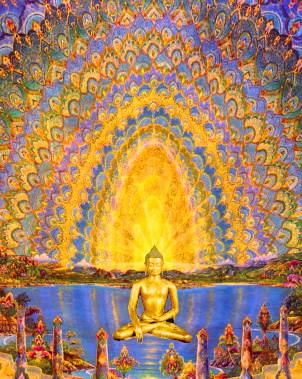 |
It is not possible for anybody who was not present to put into adequate words the sublime beauty and the profound effect of this vision upon the beholders. However in the Surangama Sutra we find the description of a similar event said to have taken place in the presence of Buddha Sakyamuni of which the paraphrase may serve as the nearest approach to the vision of Chorten Nyima.
|
After the party had returned to Dungkar Gompa each of the eyewitnesses described what he had seen, and from the combined records, with the final sanction of the Guru (who reluctantly gave in to the wishes of his disciples to have the scene recorded in the form of a fresco), the painting was consciously executed.
One of the last witnesses of this memorable incident is the present abbot of Dungkar Gompa. He explained every detail of the painting, while relating his own experiences of this pilgrimage. He pointed out what he had seen with his own eyes, and also what he had not been able to see, but what apparently had been visible to others. He also mentioned the strange fact that the vision had remained visible for hours, so that all who saw it could observe and point out to each other the minutest details.
This vision had far reaching effects upon Tomo Geshe as well as upon his disciples. it invested him with that superior authority which in Tibet is ascribed only to Tulkus, i.e. those in whom the Bodhisattva spirit, or the ideal of Buddhahood, has taken root, so that they have become its living embodiments. They have the power to direct their future rebirths according to the needs of their fellow men.
And from now on Tomo Geshe conceived the idea to bring the teachings of the Enlightened Ones not only to the people of his own country but to the world at large, irrespective of race, caste, color, or creed.
And so he stepped out of his quiet valley and travelled all over the countries of the Himalayas and to the sacred places of Buddhism in India. And wherever he went he planted hope and inspiration in the hearts of men; he healed the sick, taught those who were ready to receive the truth of the Dharma, and left in his wake many a disciple to carry on the work which the Buddhas had ordained him to do.
From: The Way of the White Clouds - A Buddhist Pilgrim in Tibet, By Lama Anagarika Govinda
Tulku - Rebirth of a Lama
| In Tibet the concept of a continuation of lives is a common belief. In the Tibetan religious system the heads of monasteries and other great spiritual leaders bridge the chasm between life and death and consciously guide their after death journey to take embodiment in a new form. The monastic leaders then search the country side, taking clues left by the departing dignitary to discover his new incarnation. He is then returned to his monastery to take up the reigns of leadership once again after a rapid relearning of his previous schooling. The Tibetan word for this new embodiment is Tulku and Tibetan literature is filled with references to the various Tulku's and the stories of their rediscovery. |
Countless tales are told throughout Tibet about extraordinary proofs of memory from previous lives and wonders worked by young tulkus to testify their identity. I could relate dozens of them, but I prefer to confine myself to the relation of facts connected with people whom I have personally known.
Next to the mansion of the Pegyai Lama, in which I lived at Kum-Bum, was the dwelling of a minor tulku called Agnai Tsang. Seven years had elapsed since the death of the last master of the place and none had been able to discover the child in whom he had reincarnated. I do not think that the caretaker of the lama's household felt greatly afflicted by that circumstance. He managed the estate and seemed rather prosperous.
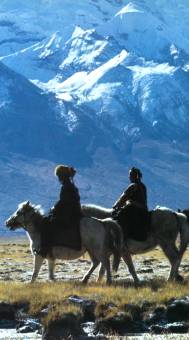 |
Now it happened that in the course of a trading tour he felt thirsty and entered a farm to rest and drink. While the housewife made tea the visiting caretaker drew a jade snuff box from his pocket and was about to take a pinch of snuff when a little boy who had been playing in a corner of the room stopped him and putting his small hand on the box asked reproachfully: "Why do you use my snuff box?"
The steward was thunderstruck. Truly the precious snuff box was not his, but belonged to the departed Agnai Tsang, and though he had not perhaps exactly intended to steal it, yet he had taken possession of it. He remained there trembling while the boy looked at him as his face suddenly became grave and stern, with no longer anything childish about it. "Give it back to me at once, it is mine," he said again.
Stung with remorse, and at the same time terrified and bewildered, the superstitious monk could only fall on his knees and prostrate himself before his reincarnated master.
A few days later, I saw the boy coming in state to his mansion. He wore a yellow brocade robe and rode a beautiful black pony, the steward holding the bridle. When the procession entered the house the boy remarked: "Why to we turn to the left to reach the second courtyard? The gate is on our right side." Now, for some reason, the gate on the right side had been walled up after the death of the lama and another one opened instead. The monks marvelled at this new proof of the authenticity of their lama and all proceeded to his private apartment where tea was to be served.
The boy, seated on a pile of large hard cushions, looked at the cup with silver gilt saucer and jeweled cover placed on the table before him. "Give me the larger china cup," he commanded. And he described one, mentioning the very pattern that decorated it. Nobody knew about such a cup, not even the steward, and the monks respectfully endeavoured to convince the young master that there was no cup of that kind in the house.
It was at that moment that, taking advantage of an already long acquaintance with the steward, I entered the room. I had heard the snuff-box story and wished to see for myself, my remarkable little new neighbor. I offered the customary complimentary scarf and a few presents. These he received with a gracious smile but, apparently following the trend of his thoughts regarding the cup, he said: "Look better, you will find it." And suddenly, as if a flash of memory had dashed through his mind, he added explanations about a box painted in such a color, which was in such a place in the store room.
The monks had briefly informed me of what was going on and I waited with interest to see how things would turn out. Less than half an hour later, the set, cup, saucer and cover, was discovered in a casket that was at the bottom of the very box described by the boy.
"I did not know of the existence of that cup," the steward told me later on. "The lama himself, or my predecessor, must have put it in the box which did not contain anything else precious and had not been opened for years."
From: Magic and Mystery in Tibet, by Alexandra David-Neel
A Tibetan Ceremony
| In this segment, Lama Anagarika Govinda was staying in an isolated village in Tibet when a strange visitor arrived unexpectedly. Although the visitor appeared to be an ordinary humble and dusty traveler, his quiet reserve and inner strength allowed him to tap into a deep spiritual power. |
Tibetans are far more psychic than most Westerners.
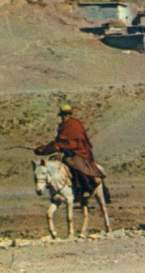 |
Since the weather was cold and cloudy, we had remained in our room, but the following day the Lama himself called on us accompanied by Namgyal. How great was our joy and surprise when we recognized the Lama as our good old Abbot of Phiyang of whom we had taken tender farewells at Tsaparang, not expecting ever to meet him again. We had regretted this all the more, as we felt that here was a man from whom we could learn a great deal, especially in the field of meditational practice, and we felt almost cheated by fate that we should lose this rare opportunity the very moment it came our way.
Whether Phiyang Lama had foreseen that we were destined to meet again or not, one thing is sure: he had read our thoughts at that time, because now, before we could even mention our secret wish, he offered to instruct us in the most advanced methods of Tantric Sadhana and Yoga practices.
As our room was not only bigger but warmer than Phiyang Lama's, since we kept a big fire going the whole day, thanks to Sherab's untiring concern for our well being, Phiyang Lama came daily with Namgyal (who thus became our Guru-bhai (fellow disciple) to instruct us and discuss our problems. it was a most fruitful time, because never was a teacher more eager to give from the wealth of his own experience than this new Guru of ours, who thus continued the good work of Tomo Geshe and Ajo Rimpoche, for which we shall remember him with deep gratitude.
When the news of Phiyang Lama's arrival and continued stay spread among the Poopas, many came to receive his blessings and finally the villagers requested him to perform a Tsewang for the whole community. The ceremony was to take place in the spacious courtyard between Phiyang Lama's quarters and our bungalow. A few days before the great ceremony he retired to his room - much to our regret, as we missed our daily meetings - though we understood that he required some time of solitude and intense concentration in order to prepare himself and to call up those forces which he wanted to communicate to others. But then it seemed to us that another Lama had joined him, probably to assist him in the forthcoming ritual, because we heard another voice much deeper than his own from time to time coming from his room. The long and sonorous recitations of the new voice were sometimes interrupted by Phiyang Lama's voice, but neither he nor the other Lama were ever seen outside. We were greatly intrigued as to who the new Lama could be, but nobody could give us any information.
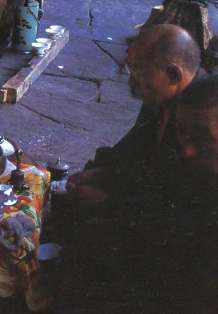 |
When the great day came, a high throne was erected in the courtyard between our bungalow and the outhouse. The throne stood against a high revetment wall, covered with a decorative cloth curtain, while the courtyard was festively decorated with the multicoloured bunting and streamers. Phiyang lama in the full regalia of an abbot was seated on the throne, his head covered with the tall red cap worn by the Nyingma and Kargyutpa Orders, to which he originally belonged, though being now the head of a Sakya Gompa. Nobody would have recognized in him the poor old pilgrim, who might have been taken as a mendicant friar on the day of his arrival. the man on the throne had the bearing of a king and the voice of a lion. His face was that of an inspired prophet, and every gesture expressed dignity and power. Whoever was present could feel that here was a man who not merely implored or invoked some unseen power, but one who had become that power, by having generated or focalized it within himself in a state of complete and sustained absorption and oneness with a particular aspect of transcendental reality. He had become the very embodiment of Tsepame, the Buddha of Infinite Life. His vision had become visible and communicable to all who attended the ritual, which held everybody spellbound and in a state of spiritual elation. The rhythm of mantric incantations and mystic gestures was like the weaving of a magic net, in which the audience was drawn together towards an invisible center. The sense of participation was heightened when everybody received Tsepame's blessings with a few drops of consecrated water and a small tse-ril, a red consecrated pill of sweetened tsampa (grain) representing the Wine and Bread of Life.
It was the most beautiful eucharistic rite we had ever witnessed, because it was performed by a man who had truly given his own blood and flesh, sacrificed his own personality, in order to make it a vessel of divine forces.
Never had I realized more thoroughly the importance of ritual in religion(and especially in community worship) and the folly of replacing it by preaching and sermonizing. Ritual - if performed by those who are qualified by spiritual training and sincerity of purpose - appeals both to the heart and to the mind, and brings people in direct contact with a deeper and richer life than that of the intellect, in which individual opinions and dogmas get the upper hand.
From: The Way of the White Clouds - A Buddhist Pilgrim in Tibet, By Lama Anagarika Govinda
 |
A Lama's Remarkable Power
| The next story is an excerpt from the biography: Tibet's Great Yogi, Milarepa (W.Y. Evans-Wentz editor). The incidents of the story took place almost a thousand years ago. As a child Milarepa was sent away by his mother to learn the black arts so that he might avenge the actions of their cruel relatives who had cheated them out of the family inheritance and treated them miserably. The sincere and devoted Milarepa becomes a proficient sorcerer, learning to call on the tutelary deities through magic rites in order to invoke their powers at controlling the elements. So well does he learn his art that almost the entire clan of heartless relatives is wiped out. Milarapa is devastated by the evil and suffering he has caused and sets out to find a teacher who can set him on the path to salvation. Eventually he finds his way to his destined teacher, Marpa the Translator, who brought to Tibet the sacred teachings of the Buddha in three arduous trips to India. Marpa put Milarepa through immense physical and psychic trials over a period of years in order to purify him and lessen his load of karma which he had heaped up unwittingly as a young sorcerer. But after years of having his hopes for initiation crushed, Milarepa finally concludes (wrongly) that Marpa will never give him the teachings he so earnestly wants so that he may escape a hellish purgatory for his evil deeds. So he sets out to find another teacher who will impart the mystic teachings that will enable him to obtain liberation in this very lifetime. At his first encounter with his new guru, Lama Ngogpa, the Lama is impressed with his young disciple because of certain omens pointing to the exceptional future in store for Milarepa. |
Lama Ngogpa said that he would surely give me the Initiation and the Consecration (as requested by Milarepa). He had been thinking of sending for me, but now that I was come myself, it was very good, indeed, and due to the Lama (Marpa's) benediction and grace. He said further, "I have a number of pupils who come from Kham, Tagpo, Kongpo, and Yarlung, but on their way hither, through depredations of those lawless folk, the Yepo and Yemo, of Dol, they are stripped of the scanty store of gear with which they set out for this place in order to pursue their studies. I therefore request thee to go and punish those lawless folk by launching a hail storm upon their lands. When thou has done that, I will bestow upon thee the Initiation and Consecration thou desirest."
I now bitterly repented the fate that had put such as accursed power into my hands, making me the means of wreaking vengeance by doing hurt to life and property. I had come here in search of the Saving Truth, and here I was again being asked to work harm and do an evil deed. If I refused, I should be disobeying a Guru, or at least, one whom I intended to take for my Guru - almost as heinous a sin as to refuse to obey an actual Guru; and, in addition, I should lose all opportunity of obtaining the Teachings. And so I decided that I must go, that I had no choice.
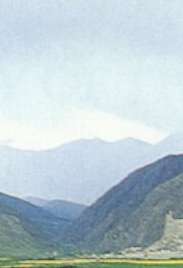 Accordingly, I set forth, provided with the necessary (magical) appurtenances; and, reaching the scene of my intended deed, I took lodgings in the house of an old woman, in the Yepo country. Just as the hail storm was about to burst, as the lightnings flashed and the thunder growled and the first hailstones were about to fall, the old woman, my hostess, began to beat her breast and weep, saying, "Alas! What shall I have to live on if my crops are destroyed by the hail?"
Accordingly, I set forth, provided with the necessary (magical) appurtenances; and, reaching the scene of my intended deed, I took lodgings in the house of an old woman, in the Yepo country. Just as the hail storm was about to burst, as the lightnings flashed and the thunder growled and the first hailstones were about to fall, the old woman, my hostess, began to beat her breast and weep, saying, "Alas! What shall I have to live on if my crops are destroyed by the hail?"This was too much for me. I could not bear to be so cruel to this poor woman, so, at imminent risk to myself, I requested her quickly to draw me a plan of her field. "Oh, my field is like this," she cried in a despairing tone, at the same time describing a triangular figure with an elongated end. I immediately covered the figure with an iron pan, in my mind shielding it from the hail, so that it escaped destruction, all except a tiny corner, which, protruding beyond the covering pan, was devastated by a gust of wind.
When the storm was over, on going out to look at the country, I saw the slopes above the valley all furrowed into ravines, the erstwhile luxuriant fields utterly laid waste, all except the old woman's field, which was quite fresh and green. But the corner of the field, corresponding to the corner of the plan which, protruding beyond the covering pan, had been devastated by wind, was damaged by the hail and flooded with water. Ever afterward, this field escaped any hail storm which visited that neighborhood.
On my way back to my new Guru, I met an old shepherd and his child who had lost their herds in the flood. By them I sent word to the people of the countryside, enjoining them to refrain thenceforth from ill-treating or robbing Lama Ngogpa's disciples or adherents, on pain of being visited constantly by similar hail storms, thus revealing to them who had caused the destruction. After this, the people of those two places were so profoundly impressed with the phenomenal power of Lama Ngogpa that they became his devoted followers and faithfully served him.
As I came along the way, I picked up some dead birds, which I found all by themselves under a bramble bush, and numbers of other birds, and some rats, which I found dead on the road, until I had my cap and the lap of my robe full. These I laid in a heap before Lama Ngogpa, and appealed to him thus: "O Reverend Teacher, I came here expecting to find the Holy Doctrine, but have been compelled to heap up sin upon sin. Have pity on such a terrible sinner!" and I burst into bitter tears.
To this the Lama replied, "Be not despairing; there is no cause whatsoever for such abject fear. We, the followers of Naropa and Maitri, possess those Truths which can save the greatest of sinners in the twinkling of an eye - just as one single stone from a sling serveth to frighten a hundred birds simultaneously. All those sentient creatures, and these birds and beasts which have been killed on this occasion by the hail storm shall be born again (in far future lives) as thy foremost disciples when thou shalt attain to Buddhahood. Till that time cometh I shall put forth my power so as to prevent their falling into Hell or degenerating into lower states of being. Therefore, be at ease. But if thou still doubt, let me prove the truth of what I say, thus." For a few moments, he sat silent with closed eyes, then he snapped his fingers. In a thrice, all the dead birds and rats which I had collected revived, and made off to their several nests and holes. I now perceived that the Lama himself was a Buddha. How delightful! How blissful! I should have rejoiced had many more creatures enjoyed the privilege of dying on such an occasion.
 |
Postscript - Tibet Irreversibly Changed
In 1950 Mao Tse Tung's Red Chinese Army invaded Tibet. The propaganda given to the Chinese citizenry at the time to explain this was that the Chinese were generously helping their "backward" brethren to the north to modernize their country. Never mind that the Tibetans wanted only to be left alone in isolation as they had been for centuries. What the Chinese soldiers saw in Tibet, they felt to be a flagrant violation of communist principles. They saw the lamaseries wherein, according to their interpretation, a few well to do lamas were being kept by thousands of monks living in poverty and supporting the "upper class" of monastic authorities. In addition, the teaching of the powerful Chinese dictator Mao Tse Tung was that "religion is poison" and the enemy of socialist ideology. Therefore the soldiers felt a powerful urge to liberate the Tibetan people by obliterating to the greatest extent possible the monastic life around which Tibetan society revolved. The Chinese army systematically destroyed almost every single monastery in the country. Of the 6,259 monasteries in Tibet before the Chinese occupation, only eight remained in 1976. In order to highlight their attitude toward religion, the Chinese went to great lengths to humiliate and ridicule Tibetan culture. Thousands of ancient Buddhist frescoes were destroyed, religious books and scrolls were burned, the ashes mixed with manure. The sacred stones carved with the prayer "Om Mani Padme Hum" were used for pavement and to make latrines. The shells of destroyed monasteries and temples were turned into shelters for barnyard animals. Statuary, jewels, gold encrusted buddhas, etc were shipped off to China to be melted down or sold. The Dalai Lama and a retinue of Tibetans fled over the border into neighboring India to set up a government in exile.By 1972, 1.2 million Tibetans had died as a result of the invasion. The resources of Tibet - forests, animal life, oil, minerals, etc have been looted away by the Chinese and used, not for modernizing Tibet, but for their own country's economic development. China provides incentives for its own citizens to relocate to Tibet to dilute the remaining Tibetan population and to further substantiate the Chinese claim over Tibet. China closely controls the media in Tibet and does not permit any free expression on the part of Tibetans who have chosen to remain in their own country. Forced birth control of Tibetans has been practiced to make the population further dwindle. Tibetans are treated as second class citizens and are not allowed to outwardly practice their religion. It is illegal to even show a picture of the Dalai Lama either in public or in private. Any kind of protests draw a swift and severe response resulting in beatings, imprisonment, torture, and even execution. Chinese have cultivated a network of spies and surveilance devices so that Tibetans have great fear even speaking their thoughts in private, much less to visitors from other countries. However according to the Chinese statements to the outside world, Tibetans are happy, allowed to practice their religion, and China is assisting in the development and education of Tibetans. This is the false picture the Chinese government attempts to present to the world. The communist government of China is fiercely defensive of any criticism of Chinese abuses in Tibet calling them "an intrusion into Chinese internal affairs". This oppression and cultural genocide continues to this day (written November, 2001).
|


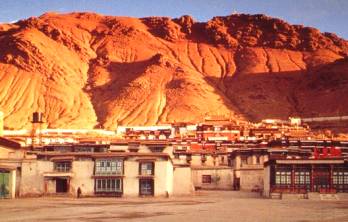




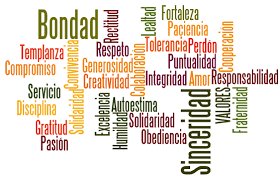
















No hay comentarios :
Publicar un comentario